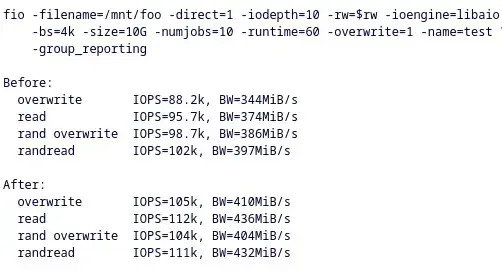Ted Ts’o sent out the EXT4 updates today for Linux 6.11. He explained in that pull request:
“Many cleanups and bug fixes in ext4, especially for the fast commit feature. Also some performance improvements; in particular, improving IOPS and throughput on fast devices running Async Direct I/O by up to 20% by optimizing jbd2_transaction_committed().”



I dislike Fedora anyways.
Why do you dislike Fedora?
I’m genuinely curious.
If you want my answer, this video sums it up pretty good: https://www.youtube.com/watch?v=x9qCqRTEVz0
More recently fedora pulled this move which causes headaches to everyone: https://gitlab.com/gnuwget/wget2/-/issues/661
To this day I notice that there is some skepticism with Btrfs, and I think it is because fedora also pushed it early.
Thank you for sharing your thoughts!
Fedora’s tendency to default to (potentially) premature software, can definitely be a legit reason to prefer other distros instead.
I’m a “(sweet) summer child” in that I’ve only been using Fedora for over two years now. Therefore, I haven’t experienced the commonly cited ‘shifts’ that have caused many issues to other users. Regardless, I do (somewhat) understand.
Regarding wget2, I didn’t even know that was a thing. Thank you for mentioning it! I have yet to understand why or how Fedora unanimously agreed to push that change.
This, however, I can’t agree with. And perhaps you’re conflating matters. Btrfs was not ready when it was first supported. However, Fedora was not an early adopter. They only defaulted to it in 2020. By contrast, AFAIK openSUSE was the first to default it in 2014. Heck, the next year it was defaulted by SLE as well. By the time Fedora did the same, the severe issues and instabilities were already ironed out. So, I’d attribute the scepticism towards Btrfs as the community’s PTSD after many community members lost valuable data early in Btrfs’ lifetime.
Extremely slow package manager (the most important one), confusing installer, fast deprecation of important technologies and testing of new technologies on its users (making major upgrades risky) is what I can remember now.
Thank you for the reply!
Fair. Though, IIRC, it’s in the same order of magnitude as
aptandzypper. But yeah;apk,pacmanandxbpsare definitely faster by a wide margin. Hopefully,dnf5will be able to close the gap significantly.I often hear this. But I’m not sure if I understand. Is it because Anaconda does not walk you (explicitly) through all parts of the installation (at least by default)? And, instead, chooses to give the user an overview (at some point) in which the user is expected to go over each one of them by themselves.
Fair. I think this is the most legitimate concern. Thankfully, over the last two years, I have yet to bang my head against a brick wall for reasons related to this. But I understand why others are more reluctant based on Fedora’s (less recent) track record.
Apt can be improved with frontends and it doesn’t take 10 minutes to sync the repos.
Idk much about it but I heard it’s slow too.
Yes.
Yea even archinstall might be better than this design lol.
X11. Though I don’t remember if they decided to drop it before explicit sync was introduced for NVidia drivers or after.
nalais indeed pretty cool.Thank you for clarifying/confirming the parts related to how Fedora’s installation is confusing.
Totally forgot about this one. Blame AMD 😛. Thank you for correcting me!
Then I guess I dislike YOUR MUM
(continuing on useless comments)
Reported
Haha okay fine if you want to XD I just made aware that such a comment is totally useless.
And it is totally useless indeed but tbh I don’t think it’s necessarily bad to make useless comments if it’s not a user asking for help.